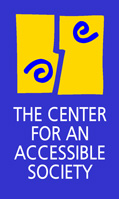
DISABILITY
ISSUES
INFORMATION
FOR JOURNALISTS
ABOUT
THE CENTER
Wed, 2 Apr 2003 -- Media Matters No. 27:
Using "news hooks" in your report
This is the second in our series of Media Matters devoted to gaining media attention for your research report.
Our last Media Matters suggested that the main audience for ANY research report should be reporters and newsmakers. It is through them, after all, that you reach the broadest audience.
To prepare your report with this audience in mind, you should really shape your report with "news hooks" in mind:
-- Is your report the first of its kind? Say so. Call it "unprecedented," "new" or "groundbreaking."
-- Is it linked to a special date or anniversary? Say so. You might want to plan it so that it can be linked to a specific date.
-- Start with the title. Think about calling it something provocative and attention-getting. Use a tag that frames the issue right from the beginning. One grassroots organization, says the SPIN project, working to end the rising tide of gay-bashing and the lack of hate crimes reporting in America, titled their document, "Statistics on Violence and Intimidation Against Gay, Lesbian, Bisexual and Transgender People." While literally descriptive, the report's title was also dry and boring. So they added this tag line above the description: "Community Under Siege and Violence Under-Reported."
-- Keep it short. Long, thousand-page tomes will not be read by most reporters. A 40- to 50-page document, including the appendix, is a good read.
Here are some news hooks you can employ to make your report interesting to reporters and editors:
-- The Strange Bedfellows Hook: Have unlikely allies come together in solidarity over your issue? Do ordinarily at-odds groups all agree with your findings? Highlight this in your report.
-- The Controversy Hook: Controversy is always newsworthy. If your report is controversial, say so, up front. Frame the controversy to put the opposition on the defense.
-- The Counter-Intuitive Hook. If you show results that turn conventional thinking on its head, make sure to spell this out. There are many counter-intuitive findings in disability research.
-- The Trendiness Hook: Frame your report so that it shows a trend toward new opinions, behavior patterns or attitudes. "Three is a trend," say editors. Highlight 3 examples in your report and point out in your title that a new trend is emerging.
-- The Calendar Hook: Tie your report to something coming up on the calendar. "Back to school" can be a hook for how schools are doing at inclusion. Mother's Day can be a hook for a report on issues facing new mothers with disabilities. "Home for the Holidays" can be used for many of our issues.
-- The Anniversary or Milestone Hook: Does your report come one year after, one decade after a newsworthy event? Build your report around that.
-- The Response and React Hook: Does your report respond or react to news others have made? Focus on that.
Other ways to give your report a news hook is to use a nationally known celebrity who's involved in your research, or who supports its findings. And don't forget to "put a face on the issue" covered in your report by including near the start of your report the stories of real people, their triumphs, tragedies, adventures and anecdotes. Focus on individuals who have fought discrimination, for example, but avoid the "inspirational overcomer" approach.
Contact us at info@accessiblesociety.org